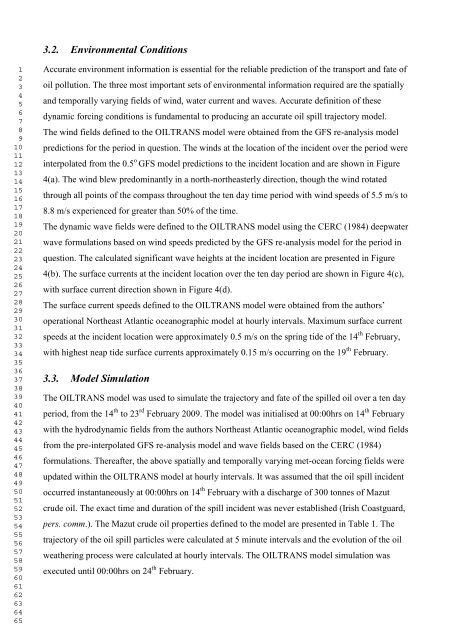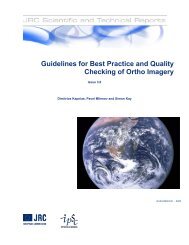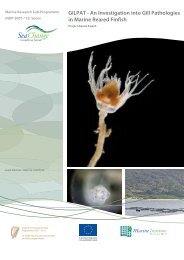The oil spill model OILTRANS and its application to the Celtic Sea ...
The oil spill model OILTRANS and its application to the Celtic Sea ...
The oil spill model OILTRANS and its application to the Celtic Sea ...
Create successful ePaper yourself
Turn your PDF publications into a flip-book with our unique Google optimized e-Paper software.
3.2. Environmental Conditions1234567891011121314151617181920212223242526272829303132333435363738394041424344454647484950515253545556575859606162636465Accurate environment information is essential for <strong>the</strong> reliable prediction of <strong>the</strong> transport <strong>and</strong> fate of<strong>oil</strong> pollution. <strong>The</strong> three most important sets of environmental information required are <strong>the</strong> spatially<strong>and</strong> temporally varying fields of wind, water current <strong>and</strong> waves. Accurate definition of <strong>the</strong>sedynamic forcing conditions is fundamental <strong>to</strong> producing an accurate <strong>oil</strong> <strong>spill</strong> trajec<strong>to</strong>ry <strong>model</strong>.<strong>The</strong> wind fields defined <strong>to</strong> <strong>the</strong> <strong>OILTRANS</strong> <strong>model</strong> were obtained from <strong>the</strong> GFS re-analysis <strong>model</strong>predictions for <strong>the</strong> period in question. <strong>The</strong> winds at <strong>the</strong> location of <strong>the</strong> incident over <strong>the</strong> period wereinterpolated from <strong>the</strong> 0.5 o GFS <strong>model</strong> predictions <strong>to</strong> <strong>the</strong> incident location <strong>and</strong> are shown in Figure4(a). <strong>The</strong> wind blew predominantly in a north-nor<strong>the</strong>asterly direction, though <strong>the</strong> wind rotatedthrough all points of <strong>the</strong> compass throughout <strong>the</strong> ten day time period with wind speeds of 5.5 m/s <strong>to</strong>8.8 m/s experienced for greater than 50% of <strong>the</strong> time.<strong>The</strong> dynamic wave fields were defined <strong>to</strong> <strong>the</strong> <strong>OILTRANS</strong> <strong>model</strong> using <strong>the</strong> CERC (1984) deepwaterwave formulations based on wind speeds predicted by <strong>the</strong> GFS re-analysis <strong>model</strong> for <strong>the</strong> period inquestion. <strong>The</strong> calculated significant wave heights at <strong>the</strong> incident location are presented in Figure4(b). <strong>The</strong> surface currents at <strong>the</strong> incident location over <strong>the</strong> ten day period are shown in Figure 4(c),with surface current direction shown in Figure 4(d).<strong>The</strong> surface current speeds defined <strong>to</strong> <strong>the</strong> <strong>OILTRANS</strong> <strong>model</strong> were obtained from <strong>the</strong> authors‟operational Nor<strong>the</strong>ast Atlantic oceanographic <strong>model</strong> at hourly intervals. Maximum surface currentspeeds at <strong>the</strong> incident location were approximately 0.5 m/s on <strong>the</strong> spring tide of <strong>the</strong> 14 th February,with highest neap tide surface currents approximately 0.15 m/s occurring on <strong>the</strong> 19 th February.3.3. Model Simulation<strong>The</strong> <strong>OILTRANS</strong> <strong>model</strong> was used <strong>to</strong> simulate <strong>the</strong> trajec<strong>to</strong>ry <strong>and</strong> fate of <strong>the</strong> <strong>spill</strong>ed <strong>oil</strong> over a ten dayperiod, from <strong>the</strong> 14 th <strong>to</strong> 23 rd February 2009. <strong>The</strong> <strong>model</strong> was initialised at 00:00hrs on 14 th Februarywith <strong>the</strong> hydrodynamic fields from <strong>the</strong> authors Nor<strong>the</strong>ast Atlantic oceanographic <strong>model</strong>, wind fieldsfrom <strong>the</strong> pre-interpolated GFS re-analysis <strong>model</strong> <strong>and</strong> wave fields based on <strong>the</strong> CERC (1984)formulations. <strong>The</strong>reafter, <strong>the</strong> above spatially <strong>and</strong> temporally varying met-ocean forcing fields wereupdated within <strong>the</strong> <strong>OILTRANS</strong> <strong>model</strong> at hourly intervals. It was assumed that <strong>the</strong> <strong>oil</strong> <strong>spill</strong> inciden<strong>to</strong>ccurred instantaneously at 00:00hrs on 14 th February with a discharge of 300 <strong>to</strong>nnes of Mazutcrude <strong>oil</strong>. <strong>The</strong> exact time <strong>and</strong> duration of <strong>the</strong> <strong>spill</strong> incident was never established (Irish Coastguard,pers. comm.). <strong>The</strong> Mazut crude <strong>oil</strong> properties defined <strong>to</strong> <strong>the</strong> <strong>model</strong> are presented in Table 1. <strong>The</strong>trajec<strong>to</strong>ry of <strong>the</strong> <strong>oil</strong> <strong>spill</strong> particles were calculated at 5 minute intervals <strong>and</strong> <strong>the</strong> evolution of <strong>the</strong> <strong>oil</strong>wea<strong>the</strong>ring process were calculated at hourly intervals. <strong>The</strong> <strong>OILTRANS</strong> <strong>model</strong> simulation wasexecuted until 00:00hrs on 24 th February.
















